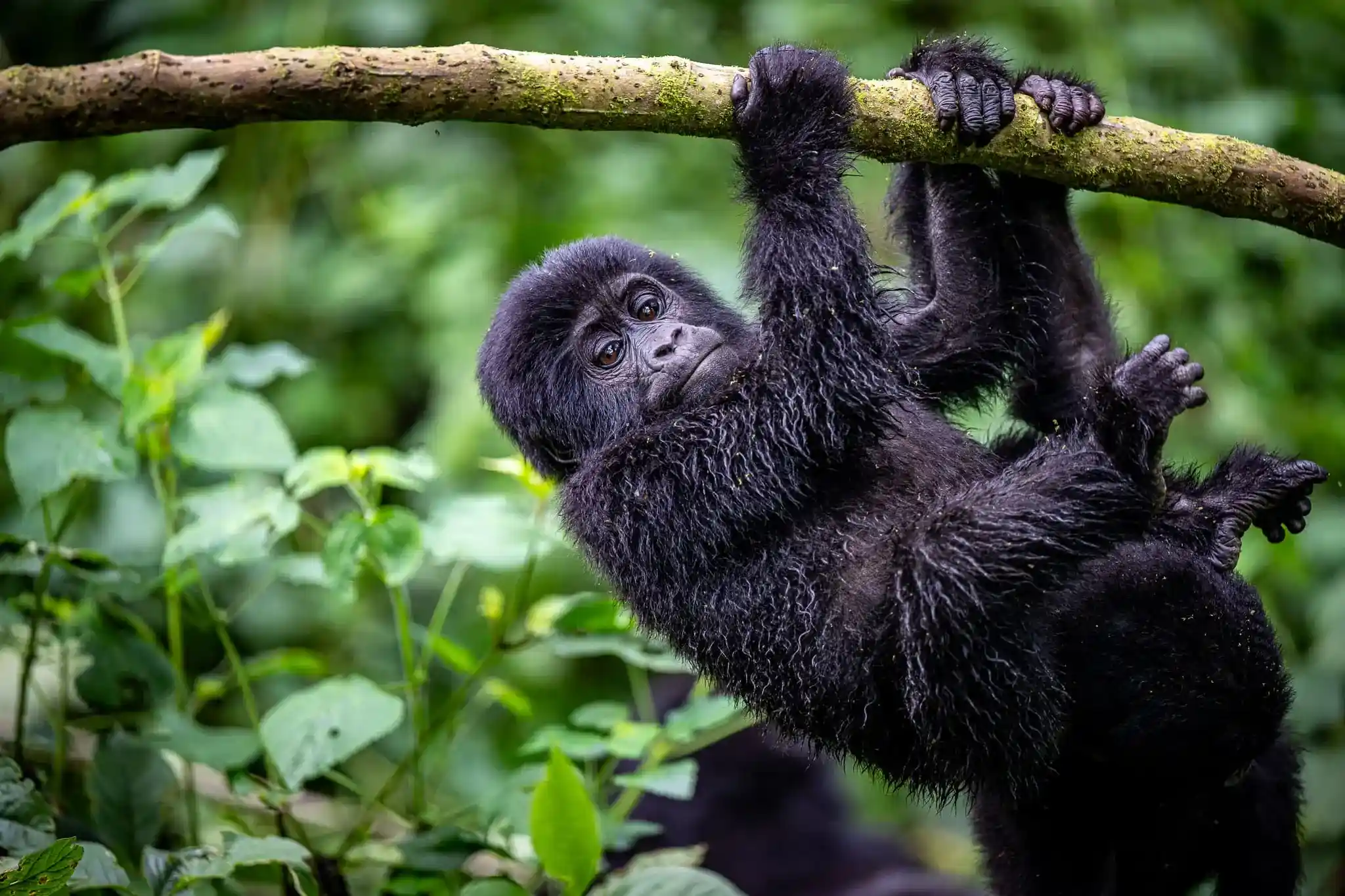
When Is The Best Time To Visit Uganda?
Uganda is a fantastic year-round destination for wildlife enthusiasts, but the best time to visit Uganda for optimal game viewing is during the two dry seasons: December to February and June to September.
During these periods, wildlife is easier to spot as animals gather around water sources, and the drier conditions make trails and roads more accessible.
Temperatures remain relatively consistent throughout the year, typically ranging from 24°C to 30°C. However, heavy rains in the wet seasons can hinder travel and make some areas difficult to reach.
The best time to visit Uganda and see mountain gorillas up close is from December to February or June to August.
These are the dry seasons, when the sky is clear, the sun is out, and the hiking trails are not too muddy. You can see gorillas all year round, but trekking through the thick Bwindi Forest is harder in the rainy season.
The walk can take several hours and involves going up and down hills. When it’s wet, the paths get muddy and slippery, and the jungle plants can be hard to get through. Still, the rainy season has some good sides. There are fewer tourists, so you might share your special gorilla moment with just a few people — or even have it all to yourself!


Uganda By Month
January
January is one of the hottest month in Uganda, with sunny weather and temperatures between 24ºC and 32ºC. It’s a perfect time to escape the heat by heading to the cool, high mountains of Bwindi Impenetrable National Park.
There, you can enjoy hiking and trekking while spotting amazing wildlife in fresh, misty air. January falls in Uganda’s short dry season, so while you might get a little rain in the forest, heavy showers are rare.
February
February is one of the best times to visit Uganda. It is one of the driest months, making it perfect for gorilla trekking and chimpanzee tracking adventures.
Usually, walking through thick forests can be hot, muddy, and tough — but in February, the dry weather makes hiking much easier and more enjoyable. With less rain and fewer leaves on the trees, it is also easier to spot animals.
You can expect sunny days, clear skies, and warm temperatures — around 29ºC in Kampala and 25ºC in Bwindi Impenetrable Forest National Park.
March
March is the start of Uganda’s long rainy season, which lasts until May.
You can expect heavy rain in the afternoons and evenings. But if you have good rain gear, visiting during this time can still be a great experience. The rain makes the land very green, and flowers start to bloom everywhere. March is also a great month for bird lovers.
The rain brings many birds to Uganda, so it’s a good time to go birdwatching. Queen Elizabeth National Park is a top spot to see some of Uganda’s 1,090 colorful bird species. It’s also less crowded this time of year, so you can enjoy the peace and quiet. Many birds leave in April and come back between early and mid-November.
April
April is the rainiest month in Uganda, but smart travelers can take advantage of lower prices and fewer crowds in the national parks. If you don’t mind a bit of rain, this is a great time to go gorilla trekking tours in Bwindi Impenetrable Forest National Park.
With fewer tourists, it is easier to secure a gorilla trekking permit. The hike can be muddy and slippery, so rain gear is a must. But there is good news — gorillas often stay in lower, warmer areas during the rainy season, so the walk to find them is usually shorter.
May
May is the end of Uganda’s long rainy season.
The weather is warm, and there is still some rain, but it starts to slow down later in the month. In Bwindi Impenetrable Forest, you can expect heavy showers, but the gorillas are still easy to see because they stay in the lower parts of the forest before moving up the mountains in June.
Hotels and lodges are easy to book in May, and prices are lower than during the busy months. There are also fewer people around, you might see gorillas with just 2 or 3 other visitors by your side.
June
June is the start of Uganda’s dry season. The rain stops, the skies turn blue, and the land stays green and beautiful. The weather is warm, with temperatures around 27ºC.
By the end of the month, the plants start to thin out, making it easier to spot big animals like lions, elephants, and more in the national parks.
June is also the beginning of Uganda’s busy season. Lodges are open, tours are running, and there’s lots of energy and excitement everywhere. If you’re planning to go gorilla trekking, it’s a good idea to book your place and permit early, because they sell out fast.
July
July is one of the best times to visit Uganda. It’s peak season, and the weather is great — around 25ºC during the day and sometimes as cool as 13ºC in Bwindi.
The dry and comfortable weather is perfect for all kinds of outdoor fun, like gorilla trekking, safaris, and boat rides on the Nile River. Animal sightings are excellent, as many gather near water, making them easy to see on game drives.
By now, the gorillas have moved back up into the misty mountains, but the dry trails make the longer hikes much easier and more enjoyable.
August
August is the driest month of the year in Uganda. The plants are few, so you can see much farther — which makes it a great time for spotting animals.
On game drives, you’ll have clear views of elephants, lions, zebras, buffalo, and more. It’s the perfect month for wildlife photography!
With open views and dry paths, you might even spot a leopard — one of the hardest animals to find. Be sure to pack some warm clothes, as nights can get chilly, with temperatures dropping to around 14ºC.
September
September is a great time to visit Uganda, especially in the first half of the month before the rainy season begins. The weather is still mostly dry, and it’s a good time to spot wildlife.
One of the best activities this month is chimpanzee trekking in the Kibale Forest National Park. This forest is home to over 1500 chimpanzees, and the dry trails make hiking easier and more fun. Seeing chimpanzees in the wild is a special experience — and early September is one of the best times to do it.
October
October is the start of Uganda’s short rainy season. The rain is not as strong as in the long rainy season (March to May), but it can still rain often.
You might get heavy showers during the day, and the trails can be muddy. Because of the rain, not many people visit Uganda in October. This means it’s easier to get a last-minute gorilla trekking permit, and many hotels offer discounts.
If you don’t mind a bit of rain, it’s a great time to visit! It usually only rains for a few hours, and there are still sunny moments with blue skies.
November
November is a quiet time to visit Uganda. The weather is a mix of rain and sunshine. You might see some rain, but more than half the days are dry.
This month is great for birdwatching, as many birds return to Uganda. If you like photography, you’ll enjoy the green landscapes and dramatic skies during afternoon rainstorms.
Temperatures can change — some days are warm (around 28ºC), and others are cooler (around 18ºC). November is also the last chance to enjoy lower prices on hotels and tours before the busy season starts again.
December
December marks the start of Uganda’s dry season, with sunny weather and less rain.
It’s the perfect time to enjoy outdoor fun in Jinja, a town by Lake Victoria and the source of the Nile River. Jinja is known as the “adventure capital of East Africa.”
You can go white-water rafting, kayaking, tubing, or take a peaceful sunset boat ride. It’s also a great place to relax by the water and enjoy the views.






